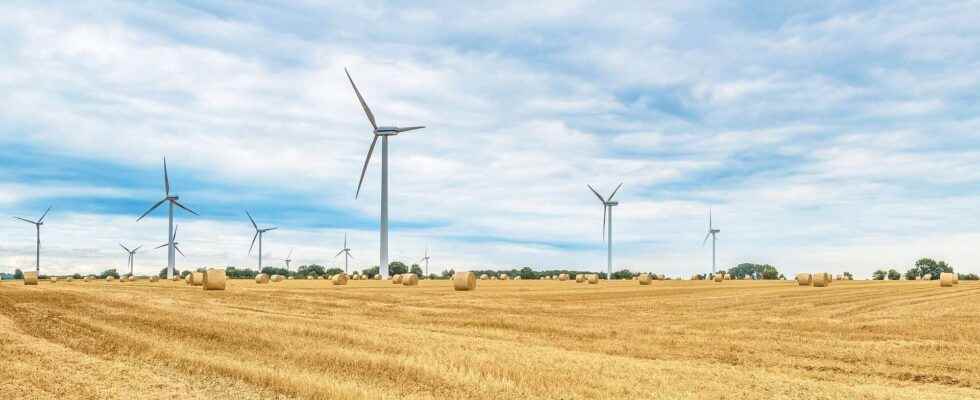At the origin of all the renewable energies that humanity exploits today, there are only two main sources: the Sun and the Earth. However, specialists like to classify these energies into five major types, each of which has its own specificities.
The term renewable energy is used to designate energies which, on a human scale at least, are inexhaustible and available in great quantity. Thus there are five main types of renewable energies: solar energy,wind power, the’Hydro-electric power, the biomass and the geothermal. Their common characteristic is that they do not produce, during the operating phase,emissions polluting (or little), and thus help to fight againstgreenhouse effect and the global warming.
Photovoltaic or thermal solar energy
Solar energy is the energy that can be obtained from the radiation of the Sun.
We must distinguish thephotovoltaic solar energy of the’solar thermal energy. THE’photovoltaic solar energy corresponds to the electricity produced by so-called photovoltaic cells. These cells receive the light of Sun and are able to transform part of it into electricity. Modularity is one of their advantages. Indeed, photovoltaic panels can be used both for domestic purposes and for large-scale energy production.
In a solar thermal system or thermodynamics, the solar radiation is used to heat a fluid. Water, for example, as in some domestic water heaters. When a system of concentration – a game of mirrors – is added to it, the Sun can heat the fluid up to around 1,000 ° C and the technology becomes exploitable, for example, for the generation of electricity.
The downside to solar power is that it is intermittent energy. It can – today in any case – be exploited only when the Sun is shining.
Air at the origin of wind power
The ancestors of wind turbines are windmills wind. The wind turbines produce energy – electricity for example, when coupled to a generator – from the displacement of air masses. They exploit thekinetic energy of wind.
Wind turbines can be installed on the Earth closed. We then speak of onshore wind turbines. They are technically the easiest to imagine. Even if the spaces that can be reserved for them could quickly run out. And the most efficient could be wind turbines installed at sea which are called offshore wind turbines.
Like solar power, thewind power is intermittent energy. Wind turbines only produce when the wind is blowing. However, unlike solar panels, it can be difficult to install a wind turbine in your garden. The technology is rather reserved for large installations.
Hydraulic energy thanks to sea currents
The termHydro-electric power refers to the energy that can be obtained by harnessing water. A category of energies less subject to weather conditions, but which remains reserved for large-scale production. In the hydraulic energies, we find :
- Dams that release large amounts of water onto turbines to generate electricity.
- THE’tidal power who plays on thepotential energy from tides, an energy linked to the differences in water levels and to the currents that these induce.
- THE’tidal power which exploits sea currents.
- Wave energy that relies onkinetic energy from waves and some swell.
- THE’thermal energy which can be drawn – in a prudent manner to avoid in particular any disturbance of the natural flows of the seas – from the temperature difference between deep water and surface water.
- THE’osmotic energy which produces electricity thanks to the difference in pressure that generates the difference of salinity between sea water andpure water.
Biomass energy from organic matter
The biomass can become a source of heat, electricity or fuel. Several techniques can be implemented to draw its energy from it: combustion, the gasification, the pyrolysis or anaerobic digestion, for example.
Biomass energy can be produced locally. But care must be taken, in certain cases, that it does not enter into competition with the food chain.
Energy biomass understand :
- The ancestral source that is the drink. It can produce heat, electricity or biofuels (hydrolysis of the cellulose in glucose then fermentation in ethanol).
- Biofuels, liquids or gaseous, resulting from the transformation of plants such as rapeseed or beet (1time generation), from materials cellulose (2e generation) or from microorganisms like microalgae (3e generation).
It should be noted that biomass can only be considered a renewable energy source if its regeneration is greater than its consumption.
Drawing energy from the ground, geothermal energy
The geothermal is a renewable energy derived from the extraction of energy contained in the soil. This heat results mainly from the radioactive decay from atoms fissiles contained in rocks. It can be used for heating, but also for the production of electricity. It is one of the only energies not dependent on atmospheric conditions.
On the other hand, it depends on the depth from which it is drawn. The geothermal deep – some 2,500 meters for 150 to 250 ° C – allows electricity to be produced. Medium geothermal energy – in deposits of water in particular from 30 to 150 ° C – supplies the urban heating networks. Very low energy geothermal energy – between 10 and 100 meters deep and less than 30 ° C – is that exploited by heat pumps.
Note, however, that for geothermal energy to remain sustainable, the rate at which this heat is drawn must not exceed the speed to which it travels inside the Earth.
Interested in what you just read?
.
fs12
